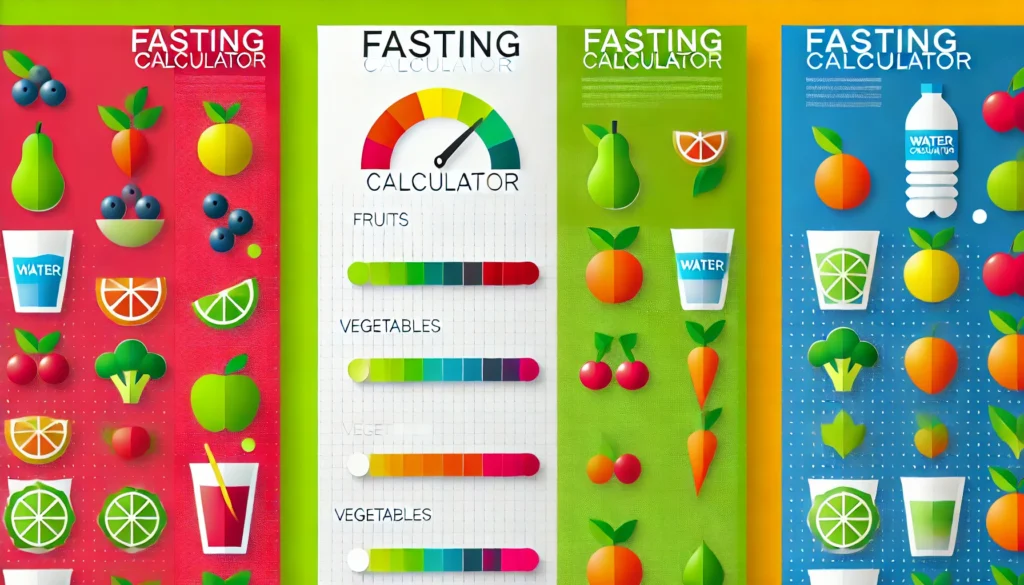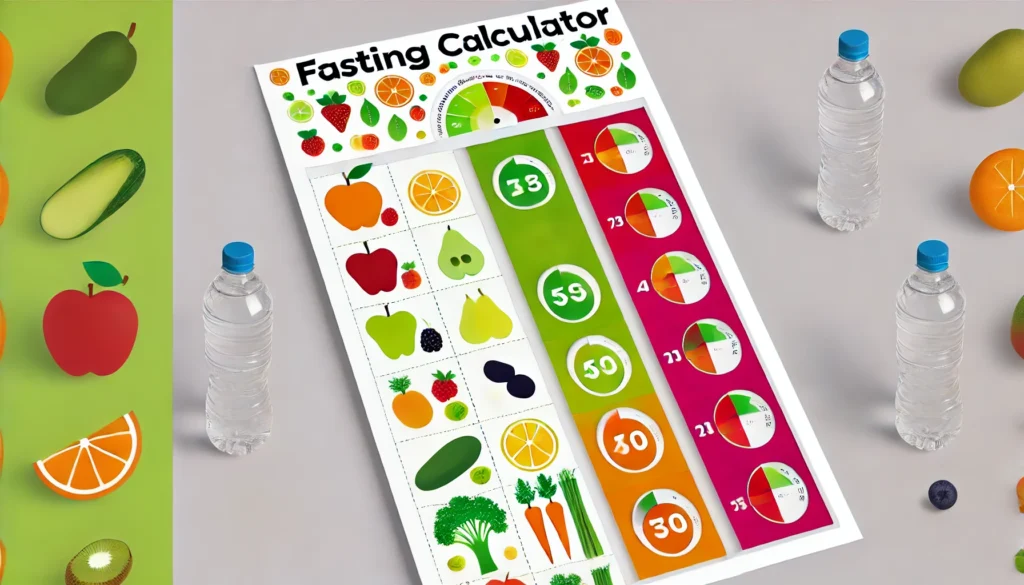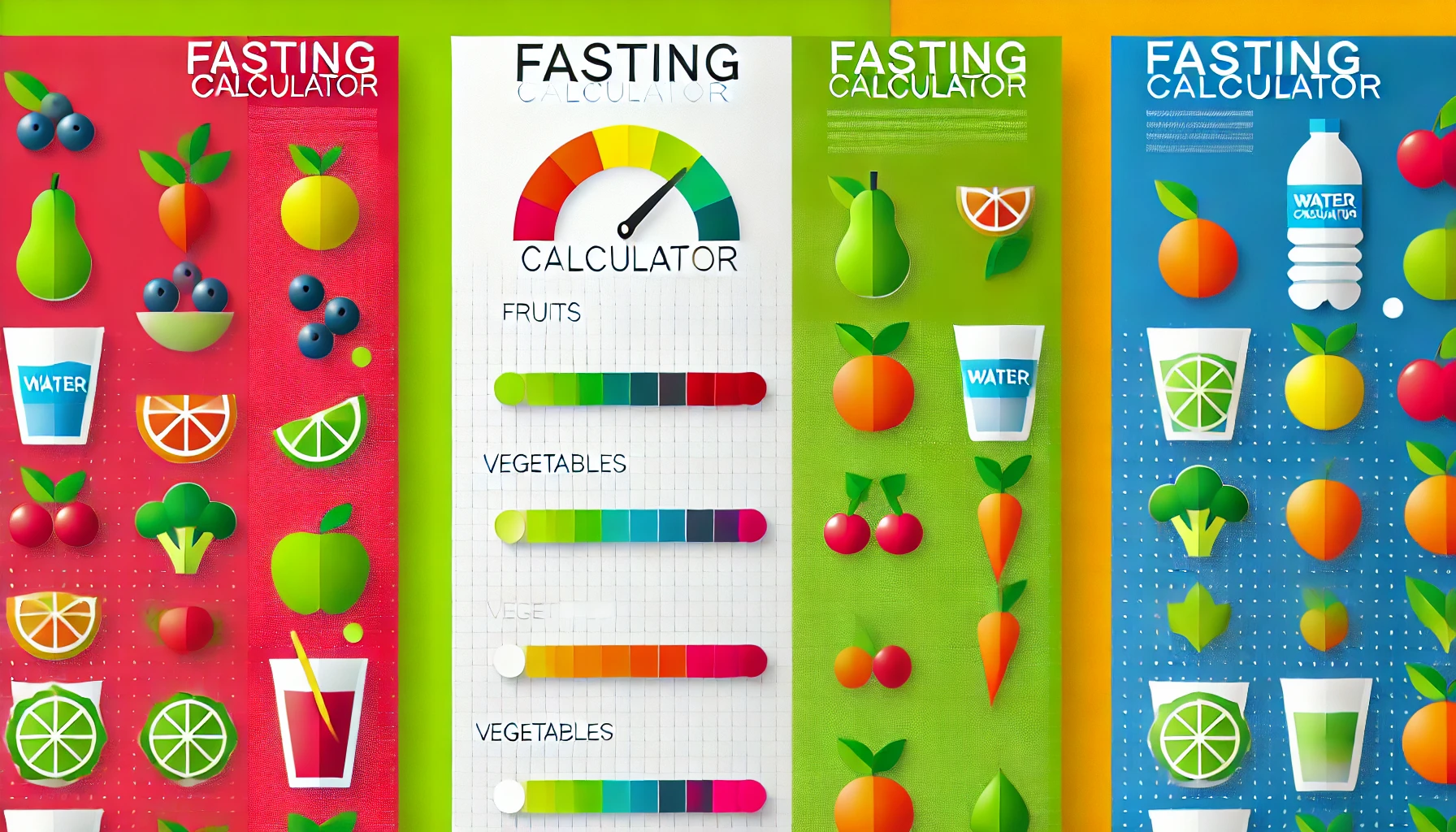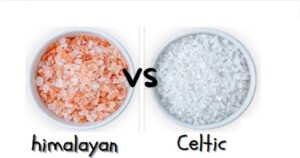Discover the benefits of fasting with our 2 Types Fasting Calculator. Easily plan and track your intermittent fasting and extended fasting schedules to optimize your health and wellness goals. Start your fasting journey today.
A fasting calculator is a digital tool designed to help individuals plan, track, and manage their fasting schedules. A fasting calculator is particularly useful for individuals who are new to fasting or those who want to optimize their fasting regimen for specific health outcomes.
These calculators can be particularly useful for those practicing intermittent fasting or other types of fasting for health, religious, or personal reasons.
Basic guidelines on How the fasting calculator works
- Input Data: The user inputs necessary data such as their fasting schedule, personal details, and health goals.
- Schedule Generation: The calculator generates a fasting schedule based on the user’s preferences. It might provide a visual timeline showing fasting and eating periods.
- Monitoring Progress: Some calculators allow users to log their food intake, track their fasting hours, and monitor their progress over time.
- Adjustments and Recommendations: Based on the user’s progress and feedback, the calculator might offer adjustments or recommendations to optimize the fasting regimen for better results.
Fasting Calculator
Fasting Calculator with alarm you can use as a reminder
Fasting Calculator
5 Key Features of a Fasting Calculator
- Fasting Type Selection: Users can choose from different types of fasting schedules, such as:
- Intermittent Fasting (IF): Includes popular methods like the 16/8 (fast for 16 hours, eat during an 8-hour window), 5:2 (eat normally for 5 days, restrict calories for 2 days), and others.
- Extended Fasting: Fasting for periods longer than 24 hours.
- Alternate Day Fasting: Alternating between days of eating and fasting.
- Intermittent Fasting (IF): Includes popular methods like the 16/8 (fast for 16 hours, eat during an 8-hour window), 5:2 (eat normally for 5 days, restrict calories for 2 days), and others.
- Customizable Fasting and Eating Windows: Users can input their preferred fasting and eating windows. For example, they can set a 16-hour fasting period starting at 8 PM and ending at 12 PM the next day.
- Personal Details: Some calculators ask for personal details such as age, gender, weight, and activity level to provide more personalized recommendations.
- Health Goals: Users can specify their health goals, such as weight loss, improving metabolic health, or enhancing mental clarity.
- Notifications and Reminders: Many fasting calculators offer notifications and reminders to help users stay on track with their fasting and eating schedule.
Example of a scenario on use of the Fasting Calculator
If someone chooses a 16/8 intermittent fasting schedule:
- Input: The user enters their eating window as 12 PM to 8 PM.
- Output: The calculator shows that their fasting period starts at 8 PM and ends at 12 PM the next day.
- Reminders: The calculator can send reminders at 7:45 PM to prepare for fasting and at 11:45 AM to prepare for the eating window.
Physiological changes that occur during a 72-hour fast.
| Time (hours) | Physiological Changes |
|---|---|
| 0 | Start of the fast. Normal blood sugar and insulin levels. |
| 4 | Blood sugar levels begin to drop slightly. Insulin levels decrease. |
| 8 | Liver starts to break down glycogen into glucose for energy. |
| 12 | Glycogen stores in the liver are being depleted. Mild hunger may start. |
| 16 | Ketogenesis begins: the body starts to produce ketones from fat. |
| 20 | Increase in growth hormone levels. Fat breakdown continues. |
| 24 | Significant increase in ketone levels. Gluconeogenesis in the liver. |
| 28 | Enhanced autophagy begins. Cells start to remove damaged components. |
| 32 | Continued fat breakdown and ketone production. Improved insulin sensitivity. |
| 36 | Further increase in autophagy. Mental clarity may improve. |
| 40 | Growth hormone levels remain elevated. Fatty acids used for energy. |
| 44 | Body’s metabolism stabilizes on ketones. Energy levels may fluctuate. |
| 48 | Autophagy is in full effect. Cells repair and regenerate. |
| 52 | Decrease in inflammation markers. Body continues to use fat for energy. |
| 56 | Improved cognitive function due to stable ketone levels. |
| 60 | Increased mitochondrial function. Enhanced cellular stress response. |
| 64 | Continued autophagy and cell regeneration. Fat stores are primary energy source. |
| 68 | Growth hormone levels peak. Enhanced muscle preservation. |
| 72 | End of the fast. Significant improvements in metabolic markers. |
What is fasting and types of fasting
Fasting is the voluntary abstention from some or all foods, and sometimes drinks, for a specific period. It has been practiced for centuries for various reasons, including religious, spiritual, health, and cultural purposes. There are different types of fasting, each with its own guidelines and purposes. Here are some common types and the principles behind them:

Types of Fasting

- 16/8 Method: Fast for 16 hours and eat during an 8-hour window each day.
- 5:2 Diet: Eat normally for 5 days of the week and restrict calorie intake (about 500-600 calories) for 2 non-consecutive days.
- Eat-Stop-Eat: Fast for 24 hours once or twice a week.
- Alternate-Day Fasting: Alternate between fasting and eating days.
- Warrior Diet: Eat small amounts of raw fruits and vegetables during the day and one large meal at night.

- Fasting for more than 24 hours, often ranging from 48 hours to several days. This type of fasting should be done with caution and ideally under medical supervision.

Ramadan: Muslims fast from dawn to sunset for a month, abstaining from all food and drink during daylight hours.

Lent: Christians, particularly Catholics, may fast or give up certain foods or meals.

Yom Kippur: Jews fast for approximately 25 hours, abstaining from all food and drink.


- Restricting certain types of food or drink rather than abstaining from all food. An example is the Daniel Fast, which involves eating only fruits, vegetables, and whole grains.


- Time restricted eating: is an eating pattern where individuals limit their food intake to specific hours of the day and fast for the remaining hours. This approach doesn’t necessarily focus on calorie reduction but on the timing of meals.

Calorie Restriction (CR): is a dietary regimen that involves reducing average daily caloric intake below usual levels, without malnutrition or deprivation of essential nutrients. The goal is to lower calorie intake while ensuring sufficient intake of vitamins, minerals, and other essential nutrients to maintain optimal health.
This graph show a research done in 2018 on Calorie Restriction with or without Time-Restricted Eating in Weight Loss.
Advantages and Disadvantages of Fasting
Advantages of Fasting
- Weight Loss:
- Advantage: Fasting can help reduce overall calorie intake, leading to weight loss. It also promotes fat burning by lowering insulin levels and increasing growth hormone.

2. Improved Metabolic Health:
- Advantage: Fasting can improve insulin sensitivity, lower blood sugar levels, and reduce the risk of type 2 diabetes.

3. Enhanced Cellular Repair:
- Advantage: Fasting triggers autophagy, a process where cells remove and recycle damaged components, leading to improved cellular health.
4. Reduced Inflammation:
- Advantage: Fasting has been shown to decrease markers of inflammation, which is linked to various chronic diseases.
5. Heart Health:
- Advantage: Fasting can improve cardiovascular health by lowering blood pressure, cholesterol levels, and triglycerides.
6. Improved Brain Function:
- Advantage: Fasting may enhance cognitive function, promote the growth of new neurons, and protect against neurodegenerative diseases.
7. Increased Longevity:
- Advantage: Some studies suggest that fasting can extend lifespan by improving metabolic and cellular health.
Disadvantages of Fasting
- Hunger and Cravings:
- Disadvantage: Fasting can lead to intense hunger and cravings, especially in the initial stages, which can be challenging to manage.
- Nutrient Deficiency:
- Disadvantage: Prolonged fasting or poorly planned fasting can result in insufficient nutrient intake, leading to deficiencies.
- Energy Levels:
- Disadvantage: Fasting can cause fatigue, low energy, and reduced physical performance, particularly during the adaptation phase.
- Social and Lifestyle Impact:
- Disadvantage: Fasting can interfere with social activities and meal routines, making it difficult to maintain in social settings.
- Potential Health Risks:
- Disadvantage: For individuals with certain medical conditions, fasting can be risky. It may exacerbate conditions like eating disorders, diabetes, or heart problems.
- Difficulty in Adherence:
- Disadvantage: Maintaining a fasting regimen over the long term can be challenging, leading to potential failure and frustration.
- Impact on Muscle Mass:
- Disadvantage: Without proper planning, fasting can lead to muscle loss, particularly if protein intake is not adequately maintained.
Health Benefits of Fasting
Weight Loss and Fat Loss: Fasting can help reduce calorie intake and boost metabolism, leading to weight loss.
Improved Metabolic Health: Fasting can improve insulin sensitivity, reduce blood sugar levels, and lower the risk of type 2 diabetes.

Cellular Repair Processes: Fasting can trigger autophagy, a process where cells remove damaged components and regenerate.
Reduced Inflammation: Fasting has been shown to reduce markers of inflammation, which is linked to various chronic diseases.
Heart Health: Fasting can improve risk factors such as blood pressure, cholesterol levels, and triglycerides.
Brain Health: Fasting may enhance brain function, promote the growth of new neurons, and protect against neurodegenerative diseases.
How Fasting Works
- Energy Source: During fasting, the body shifts from using glucose (from carbohydrates) as its primary energy source to using ketones (from fat) once glycogen stores are depleted.
- Hormonal Changes: Fasting leads to a decrease in insulin levels and an increase in human growth hormone (HGH), both of which facilitate fat burning and muscle preservation.

- Autophagy: Prolonged fasting triggers autophagy, helping to remove and recycle damaged cellular components.
Ultimate Fasting Methods
1. 16:8 method (16 hours fasting, 8 hours eating)
The 16:8 method is a type of intermittent fasting where you fast for 16 hours and restrict your eating to an 8-hour window each day. Here’s a brief explanation:
Fasting Period (16 hours): During this time, you abstain from consuming any calories. You can drink water, tea, coffee (without sugar or cream), and other non-caloric beverages. This period typically includes the hours you’re asleep, making it easier to manage.
Eating Window (8 hours): During this 8-hour window, you consume all your daily calories. Many people choose an eating window that aligns with their lifestyle, such as 12:00 PM to 8:00 PM or 10:00 AM to 6:00 PM. During this time, it’s important to eat balanced and nutritious meals.
The 16:8 method is popular for its simplicity and flexibility. It may help with weight loss, improve metabolic health, and simplify meal planning. However, it’s important to choose nutritious foods and maintain a balanced diet during the eating window.
2. The 5:2 diet (normal eating for 5 days, restricted calories for 2 days)
5:2 diet is another form of intermittent fasting that involves eating normally for five days of the week and restricting calorie intake for the other two days. Here’s a brief explanation:
Normal Eating (5 days): On these days, you eat your regular, healthy diet without any calorie restrictions. It’s important to maintain a balanced diet with adequate nutrients.
Restricted Eating (2 days): On the two non-consecutive fasting days, you significantly reduce your calorie intake, typically to about 500-600 calories per day. These days can be any two days of the week, but they should not be consecutive.
5:2 diet is praised for its flexibility and simplicity, allowing for regular eating most of the week while still offering the benefits of intermittent fasting, such as weight loss and improved metabolic health. However, like all diets, it’s essential to focus on nutrient-rich foods and consult with a healthcare provider before starting, especially for individuals with medical conditions.
3. Alternate-day fasting (normal eating one day, minimal or no calories the next)
Alternate-day fasting (ADF) is an intermittent fasting regimen where individuals alternate between days of normal eating and days of minimal or no calorie intake.
On fasting days, people typically consume about 25% of their usual caloric intake, or some may choose to consume no calories at all. On feeding days, they eat normally without specific calorie restrictions.
This pattern aims to promote weight loss, improve metabolic health, and potentially offer other health benefits by reducing overall calorie intake and allowing the body periods of rest from digestion.
4. OMAD (One Meal A Day)
OMAD (One Meal A Day) is an intermittent fasting approach where individuals consume all their daily calories in a single meal within a one-hour window, and fast for the remaining 23 hours of the day.
This method aims to simplify eating schedules, reduce overall calorie intake, and potentially improve metabolic health. People following OMAD typically eat a nutrient-dense meal that includes a balance of proteins, fats, and carbohydrates to ensure they meet their nutritional needs.
The extended fasting period is believed to promote benefits such as weight loss, improved insulin sensitivity, and enhanced autophagy.
5. 20:4 fasting (Warrior Diet)
The 20:4 fasting, also known as the Warrior Diet, is an intermittent fasting regimen where individuals fast for 20 hours and then consume all their daily calories within a 4-hour eating window.
During the 20-hour fasting period, individuals are allowed to consume small amounts of certain foods and beverages, such as raw fruits and vegetables, small portions of protein, and non-caloric drinks like water, coffee, or tea.
The 4-hour eating window typically takes place in the evening and focuses on consuming one large meal that is rich in nutrients, emphasizing whole, unprocessed foods.
The Warrior Diet aims to align with the natural eating patterns of early humans, potentially offering benefits such as weight loss, improved energy levels, enhanced mental clarity, and better digestion.
The extended fasting period is believed to promote fat burning and support overall metabolic health.
6. Whole-day fasting (24-hour fast once or twice a week)
Whole-day fasting, also known as a 24-hour fast, involves abstaining from all caloric intake for a full 24 hours once or twice a week. During this fasting period, individuals only consume non-caloric beverages such as water, tea, or black coffee.
For example, if you finish dinner at 7 PM, you would fast until 7 PM the next day. The remaining days of the week involve regular eating patterns without specific calorie restrictions.
The primary goals of whole-day fasting are to reduce overall calorie intake, promote weight loss, improve metabolic health, and enhance cellular repair processes. The fasting period allows the body to use stored fat for energy, potentially leading to fat loss and improved insulin sensitivity. Additionally, this type of fasting is believed to support autophagy, the body’s process of cleaning out damaged cells and regenerating new ones.
6. Common Mistakes to Avoid when fasting
- Not consuming enough calories during eating periods
- Not staying hydrated
- Jumping into extreme fasting regimens too quickly
- Incorrect timing of exercise
- Expecting instant results
Side Effects and Safety Concerns of fasting
- Common side effects (hunger, fatigue, insomnia, nausea, headaches)
- Suitability of intermittent fasting for different groups (e.g., pregnant women, people with certain medical conditions)
- Consulting with a physician before starting a fasting regimen
Resources
https://www.healthline.com/nutrition/fasting-benefits









